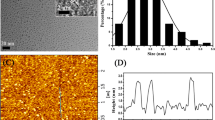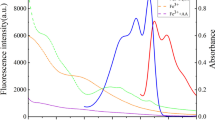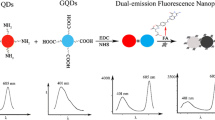Abstract
A novel and sensitive method based on nitrogen-doped carbon quantum dots as a fluorescence probe coupled with magnetic solid-phase extraction (MSPE) purification for analysis of folic acid (FA) in human serum samples has been established for the first time. In the developed system, magnetic nanoparticles coated with hexanoic acid (Fe3O4@C6) were synthesized by a one-step chemical co-precipitation method with good magnetic properties and dispersibility for sample purification, and it is better to be separated from the sample. High fluorescence nitrogen-doped carbon quantum dots (N-CQDs), simply prepared using a one-step hydrothermal method with nitrilotriacetic acid, could be selectively quenched by FA. Based on this phenomenon, a fluorescence assay was proposed for specific determination of FA. Various operational experiment parameters have been studied and optimized in detail. Under the optimum experimental conditions, the detection limit of the proposed method for FA was evaluated to be 0.5 nM (S/N = 3), while the relative standard deviation (RSD) was 1.2% (n = 6). Finally, the proposed method was applied for determination of trace levels of FA from human serum samples and quantitative recoveries were achieved within the range of 95.7–103.5%. All of the results showed that the proposed method had significant application in further research.

Schematic of synthesis of N-CQDs and schematic of suggested mode for analysis of folic acid (FA).






Similar content being viewed by others
References
Quaglia M, Chenon K, Hall AJ, De LE, Sellergren B. Target analogue imprinted polymers with affinity for folic acid and related compounds. J Am Chem Soc. 2001;123(10):2146.
Kalimuthu P, John SA. Selective electrochemical sensor for folic acid at physiological pH using ultrathin electropolymerized film of functionalized thiadiazole modified glassy carbon electrode. Biosens Bioelectron. 2009;24(12):3575–80.
Dai H, Li Y, Zhang S, Gong L, Li X, Lin Y. Delicate photoelectrochemical sensor for folic acid based on carbon nanohorns supported interwoven titanate nanotubes. Sensor Actuat B Chem. 2016;222:120–6.
Xiao F, Ruan C, Liu L, Yan R, Zhao F, Zeng B. Single-walled carbon nanotube-ionic liquid paste electrode for the sensitive voltammetric determination of folic acid. Sensor Actuat B Chem. 2008;134(2):895–901.
Lermo A, Fabiano S, Hernandez S, Galve R, Marco M, Alegret S, et al. Immunoassay for folic acid detection in vitamin-fortified milk based on electrochemical magneto sensors. Biosens Bioelectron. 2009;24(7):2057–63.
Zhu Z, Wu H, Wu S, Huang Z, Zhu Y, Xi L. Determination of methotrexate and folic acid by ion chromatography with electrochemical detection on a functionalized multi-wall carbon nanotube modified electrode. J Chromatogr A. 2013;1283(6):62–7.
Prasad BB, Madhuri R, Tiwari MP, Sharma PS. Electrochemical sensor for folic acid based on a hyperbranched molecularly imprinted polymer-immobilized sol–gel-modified pencil graphite electrode. Sensor Actuat B Chem. 2010;146(1):321–30.
Rao GR, Kanjilal G, Mohan KR. Extended application of Folin-Ciocalteu reagent in the determination of drugs. Analyst. 1978;103(1230):993–4.
Rui ASL, Lima JFC, Reis BF, Santos JLM, Zagatto EAG. Photochemical-fluorimetric determination of folic acid in a multicommutated flow system. Anal Chim Acta. 1997;351(1):223–8.
Zhang BT, Zhao L, Lin JM. Determination of folic acid by chemiluminescence based on peroxomonosulfate-cobalt(II) system. Talanta. 2008;74(5):1154–9.
Lebiedzińska A, DąBrowska M, Szefer P, Marszałł M. High-performance liquid chromatography method for the determination of folic acid in fortified food products. Toxicol Mech Methods. 2008;18(6):463–7.
Wang H, Lu Q, Hou Y, Liu Y, Zhang Y. High fluorescence S,N co-doped carbon dots as an ultra-sensitive fluorescent probe for the determination of uric acid. Talanta. 2016;155:62–9.
Deng X, Guo Q, Chen X, Xue T, Wang H, Yao P. Rapid and effective sample clean-up based on magnetic multiwalled carbon nanotubes for the determination of pesticide residues in tea by gas chromatography–mass spectrometry. Food Chem. 2014;145(7):853.
Pan SD, Chen XH, Shen HY, Li XP, Cai MQ, Zhao YG, et al. Rapid and effective sample cleanup based on graphene oxide-encapsulated core-shell magnetic microspheres for determination of fifteen trace environmental phenols in seafood by liquid chromatography-tandem mass spectrometry. Anal Chim Acta. 2016;919:34–46.
Shamsipur M, Rajabi HR. Pure zinc sulfide quantum dot as highly selective luminescent probe for determination of hazardous cyanide ion. Mat Sci Eng C-Mater. 2014;36(1):139–45.
Rajabi HR, Shamsipur M, Khosravi AA, Khani O, Yousefi MH. Selective spectrofluorimetric determination of sulfide ion using manganese doped ZnS quantum dots as luminescent probe. Spectrochim Acta A. 2013;107(7):256–62.
Mewada A, Pandey S, Thakur M, Jadhav D, Sharon M. Swarming carbon dots for folic acid mediated delivery of doxorubicin and biological imaging. J Mater Chem B. 2014;2(6):698–705.
Heinrichs RW, Ammari N. Polyamine-functionalized carbon quantum dots as fluorescent probes for selective and sensitive detection of copper ions. Anal Chem. 2012;84(14):6220.
Zhang YL, Wang L, Zhang HC, Liu Y, Wang HY, Kang ZH, et al. Graphitic carbon quantum dots as a fluorescent sensing platform for highly efficient detection of Fe3+ ions. RSC Adv. 2013;3(11):3733–8.
Simões EFC, Leitão JMM, Esteves da Silva JCG. Carbon dots prepared from citric acid and urea as fluorescent probes for hypochlorite and peroxynitrite. Microchim Acta. 2016;183(5):1769–77.
Chen H, Li W, Zhao P, Nie Z, Yao S. A CdTe/CdS quantum dots amplified graphene quantum dots anodic electrochemiluminescence platform and the application for ascorbic acid detection in fruits. Electrochim Acta. 2015;178:407–13.
Kim SRA, Jongsung. Selective detection of dopamine in the presence of ascorbic acid via fluorescence quenching of InP/ZnS quantum dots. Int J Nanomedicine. 2015;10(Spec Iss):113.
Zhang H, Chen Y, Liang M, Xu L, Qi S, Chen H, et al. Solid-phase synthesis of highly fluorescent nitrogen-doped carbon dots for sensitive and selective probing ferric ions in living cells. Anal Chem. 2014;86(19):9846.
Shen LM, Liu J. New development in carbon quantum dots technical applications. Talanta. 2016;156-157:245.
Chen J, Liu J, Li J, Xu L, Qiao Y. One-pot synthesis of nitrogen and sulfur co-doped carbon dots and its application for sensor and multicolor cellular imaging. J Colloid Interf Sci. 2017;485:167–74.
Zhu L, Xu G, Song Q, Tang T, Wang X, Wei F, et al. Highly sensitive determination of dopamine by a turn-on fluorescent biosensor based on aptamer labeled carbon dots and nano-graphite. Sensor Actuat B Chem. 2016;231:506–12.
Cheng G, He M, Peng H, Hu B. Dithizone modified magnetic nanoparticles for fast and selective solid phase extraction of trace elements in environmental and biological samples prior to their determination by ICP-OES. Talanta. 2012;88(1):507.
Chen J, Zhu X. Magnetic solid phase extraction using ionic liquid-coated core-shell magnetic nanoparticles followed by high-performance liquid chromatography for determination of Rhodamine B in food samples. Food Chem. 2016;200:10–5.
He Y, Li N, Ma JJ. Magnetic solid-phase extraction clean-up combined with solidified floating organic drop microextraction for determination of trace mercury (II) in tea samples. J Chem Soc Pakistan. 2014;36(6):1162–8.
Henry B. Preparation and characterization of graphene quantum dots-Fe3O4 nanocomposite as an efficient adsorbent in magnetic solid phase extraction: application to determination of bisphenol A in water samples. Anal Methods. 2014;6(20):8413–9.
Liao W, Ma Y, Chen A, Yang Y. Preparation of fatty acids coated Fe3O4 nanoparticles for adsorption and determination of benzo(a)pyrene in environmental water samples. Chem Eng J. 2015;271:232–9.
Liu Y, Zhao Y, Zhang Y. One-step green synthesized fluorescent carbon nanodots from bamboo leaves for copper(II) ion detection. Sensor Actuat B Chem. 2014;196(2):647–52.
Li W, Zhang Z, Kong B, Feng S, Wang J, Wang L, et al. Simple and green synthesis of nitrogen-doped photoluminescent carbonaceous nanospheres for bioimaging. Angew Chem Int Ed Engl. 2013;52(31):8151–815.
Huang H, Li C, Zhu S, Wang H, Chen C, Wang Z, et al. Histidine-derived nontoxic nitrogen-doped carbon dots for sensing and bioimaging applications. Langmuir. 2014;30(45):13542–8.
Liao J, Cheng Z, Zhou L. Nitrogen-doping enhanced fluorescent carbon dots: green synthesis and their applications for bioimaging and label-free detection of Au3+ ions. ACS Sustain Chem Eng. 2016;4(6):3053–61.
Wang R, Wang X, Sun Y. One-step synthesis of self-doped carbon dots with highly photoluminescence as multifunctional biosensors for detection of iron ions and pH. Sensor Actuat B Chem. 2016;241:73–9.
Li X, Chen L. Fluorescence probe based on amino-functionalized fluorescent magnetic nanocomposite for detection of folic acid in serum. ACS Appl Mater Inter. 2016;8:46.
Arvand M, Dehsaraei M. A simple and efficient electrochemical sensor for folic acid determination in human blood plasma based on gold nanoparticles-modified carbon paste electrode. Mat Sci Eng C. 2013;33(6):3474.
Aurora-Prado MS, Silva CA, Tavares MFM, Altria KD. Determination of folic acid in tablets by microemulsion electrokinetic chromatography. J Chromatogr A. 2004;1051(1–2):291–6.
Geszke-Moritz M, Clavier G, Lulek J, Schneider R. Copper- or manganese-doped ZnS quantum dots as fluorescent probes for detecting folic acid in aqueous media. J Lumin. 2012;132(4):987–91.
Funding information
The work was strongly supported by the Analysis and Testing Foundation of Kunming University of Science and Technology.
Author information
Authors and Affiliations
Corresponding author
Ethics declarations
Conflict of interest
The authors declare that they have no conflict of interest.
Ethical approval
Informed consent was obtained from all individual participants serum samples were collected from. The studies have been approved by Kunming University of Science and Technology Ethics Committee and Carnegie Mellon University Ethics Committee and have been performed in accordance with the ethical standards.
Rights and permissions
About this article
Cite this article
Wang, M., Jiao, Y., Cheng, C. et al. Nitrogen-doped carbon quantum dots as a fluorescence probe combined with magnetic solid-phase extraction purification for analysis of folic acid in human serum. Anal Bioanal Chem 409, 7063–7075 (2017). https://doi.org/10.1007/s00216-017-0665-3
Received:
Revised:
Accepted:
Published:
Issue Date:
DOI: https://doi.org/10.1007/s00216-017-0665-3




